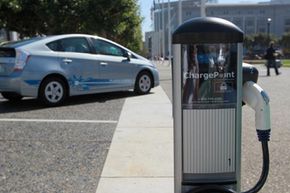Electricity tends to be cheaper than gasoline, so getting a car that runs off the electricity in your home not only can save trips to the gas station, but it can also save you cash. Charging a plug-in hybrid, however, is a little more complex than plugging in your cell phone at the end of a long day.
Technically, you don't need to change your home's wiring to charge a plug-in hybrid. Most come with kits that allow you to plug into any standard outlet. Plugging into a plain old 120-volt outlet, the kind you probably have in your garage already, works for charging plug-in hybrids. However, while plugging into a regular outlet will charge your plug-in hybrid, it may not be the best option.
Advertisement
Charging a plug-in hybrid requires a lot of power, and if you plug into a 120-volt outlet, well, you may be fine -- or you may end up overloading the circuit and tripping the circuit breaker. You can avoid that by making sure that you have a dedicated circuit for charging your plug-in hybrid if you're going to use a 120-volt outlet.
Another downside of a 120-volt outlet for plug-in hybrid charging is that it takes longer than if you were using a more powerful source. Many car companies recommend the plug-in hybrid owners use a 240-volt charging station to charge their plug-in hybrids. These stations must be installed by a licensed electrician and cost about $2,000, but with one, you lessen your risk of blowing a circuit and shorten your charging time. So while you don't need special wiring to charge your plug-in hybrid at home, it certainly doesn't hurt.
Advertisement



